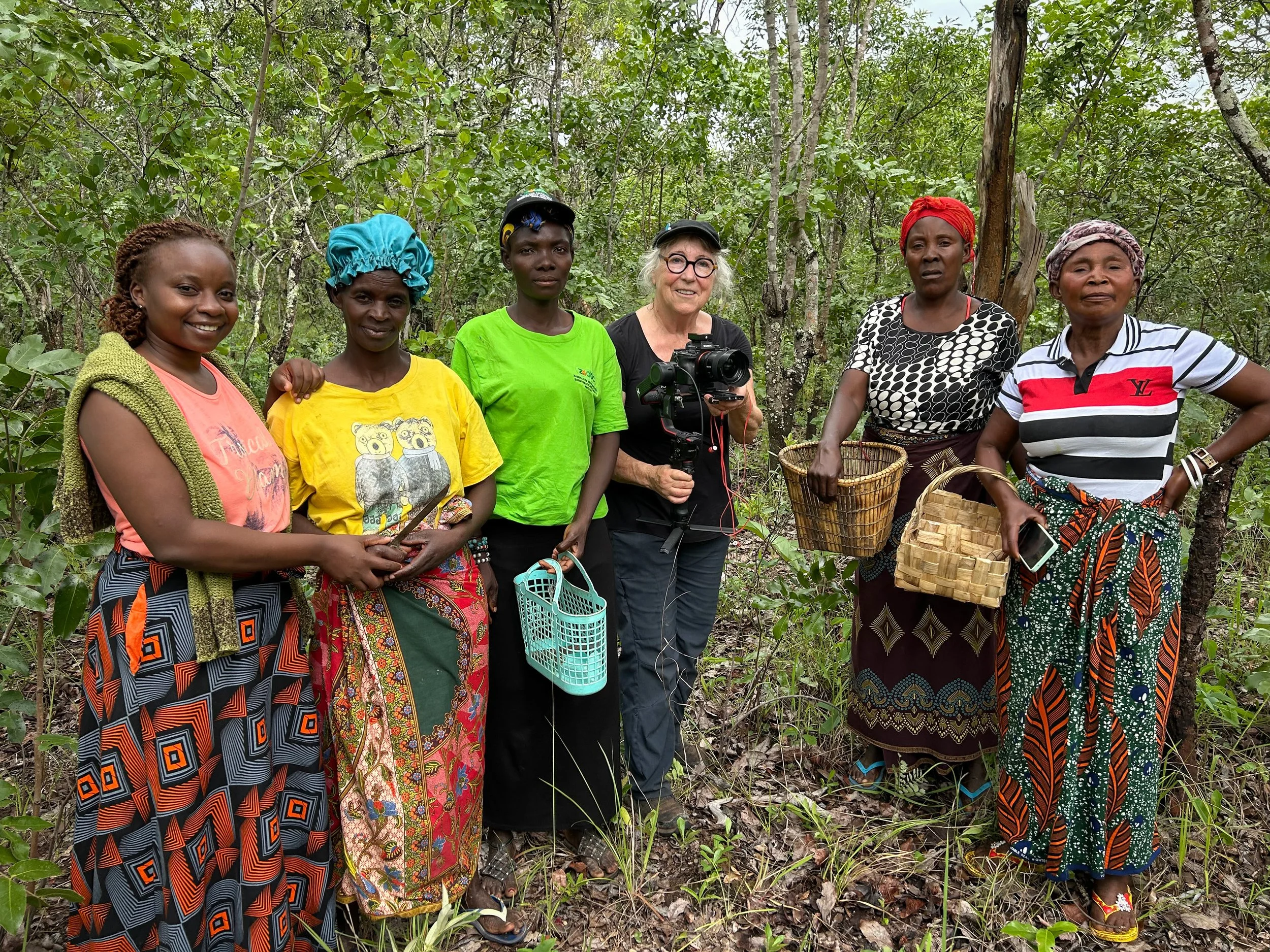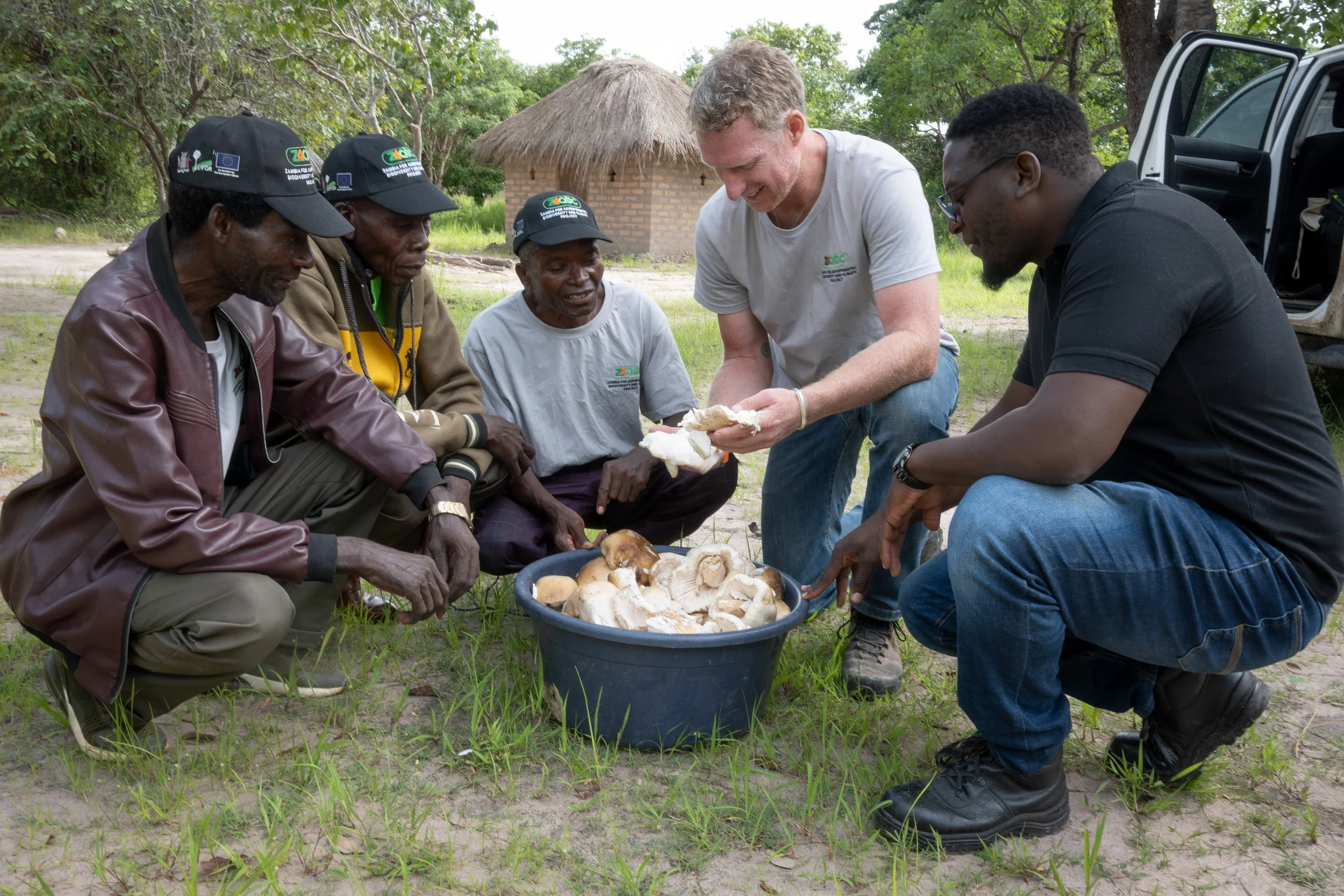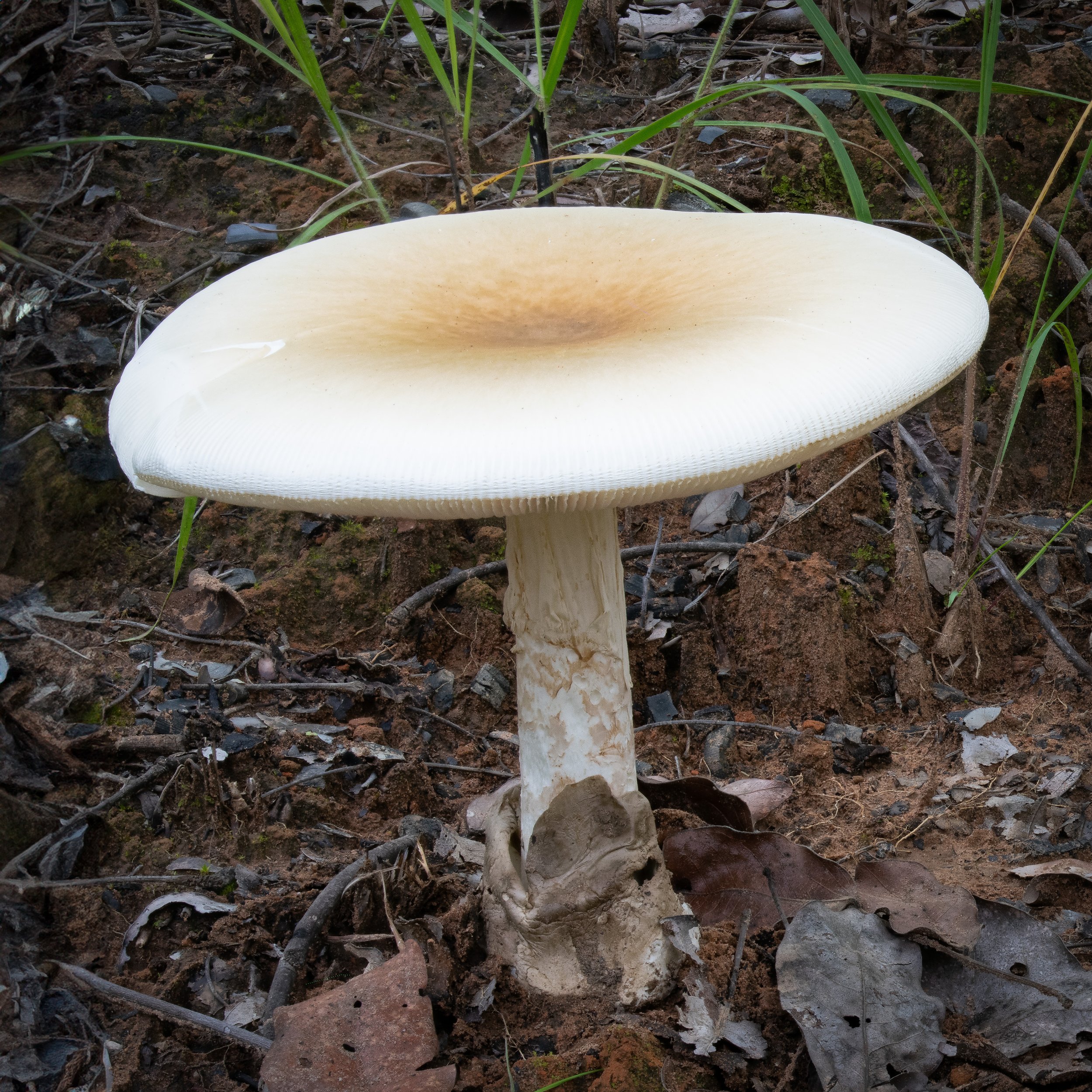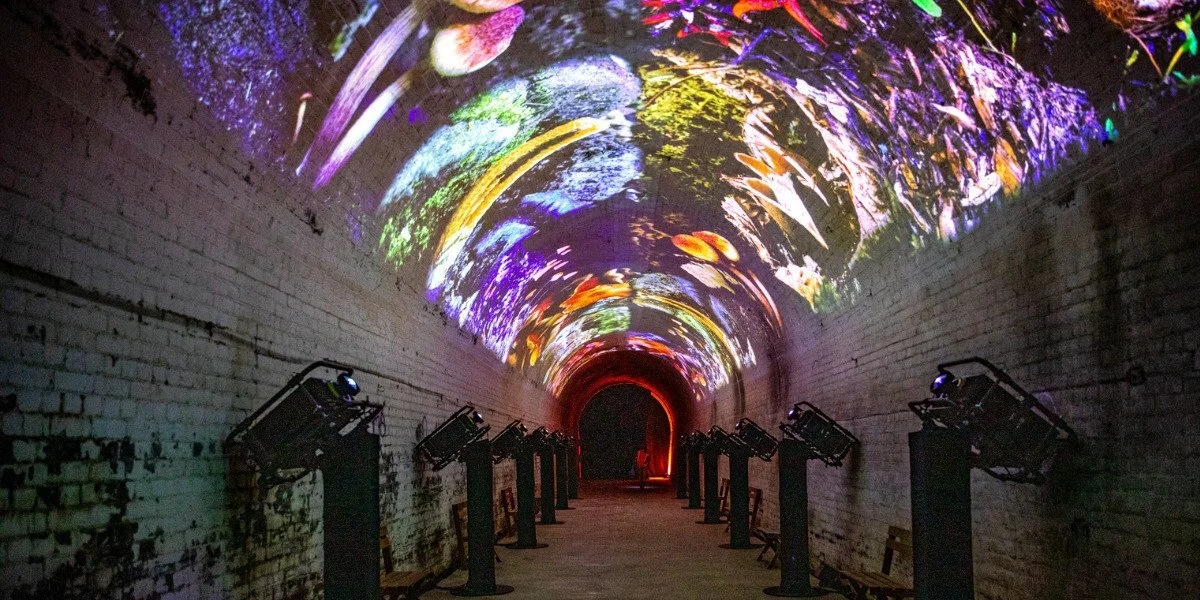Hidden Bounty – Fungi Hunting in Zambia🍄🟫🌿
Newly emerged Amanita pudica from it’s tell-tale Amanita ovoidea - non-edible.
From the untamed beauty of Zambia’s Miombo woodlands to the thrill of photographing rare fungi under the watchful eye of black mambas, our latest adventure documents a hidden bounty. 🐍📸🍄🟫 Plus, Stephen Axford’s expert tips on capturing the story of a fungus for identification, how you can help us get Follow the Rain onto screens near you and links to the fungi events at Adelaide Fringe Festival.
Stephen Axford with village headman Simon Fibeti. Our first glimpse of the popular Zambian edible mushroom Amanita loosii or Tente.
What a start to 2025
In January, we followed the rain to the breathtaking Miombo woodlands of Zambia’s Muchinga region for an incredible assignment with CIFOR-ICRAF.
Over three weeks, we documented the region’s fascinating mushrooms and filmed a short documentary about an inspiring pilot program, Zambia For Agroforestry, Biodiversity and Climate (Z4ABC). Learn more here
This initiative is about more than just mushrooms—it’s transforming lives.
Z4ABC is helping local villagers bring their wild-harvested mushrooms to markets across Africa, Europe, and beyond. 🍄🟫🛖🚛🌎
L-R Lydia Amanzi (CIFOR-ICRAF Zambia’s Communications Officer) and featuring in our short documentary are local wild mushroom harvesting experts Theresa Kabaye, Iris Kango, Joyce Kaimba and Margaret Mwape. That’s Catherine in the middle with the camera.
The team of Z4ABC are even experimenting with innovative techniques to stimulate more mushroom growth, boosting food security, biodiversity, and livelihoods along the way.
It’s a powerful example of how agriculture, forestry and wildlife value chains can evolve to be more sustainable and climate-resilient.
L-R Kunda Kango (CFMG chairman), Progress Mwaba, Simon Fibeti (Headman), Professor Peter Mortimer (Applied Symbiotics) and Chilala Ndeke (Z4ABC Pilot Landscape Co-ordinator). Photograph by Lydia Amanzi CIFOR-ICRAF.
We were lucky to work alongside a fantastic team from CIFOR-ICRAF, local experts and our long-time collaborator, Professor Peter Mortimer—the brilliant mycologist you may remember from the China sequence of the IMAX documentary Fungi: Web of Life.
Also joining us was the legendary Professor Mike Wingfield (FABI), a renowned forest biotechnologist and one of the world’s most highly cited researchers. From pioneering work on tree health to mentoring future generations of scientists, his contributions are nothing short of legendary. Let’s just say, Stephen and I felt like students at the feet of a master.
Marasmius bekolacongoli
Of course, it wasn’t all science and filming—we had plenty of time to marvel at the fungi themselves. One tiny treasure stole our hearts: Marasmius bekolacongoli, a beautiful striped parasol sprinkling the leaf litter.
📽️ Coming Soon… ‘Nature’s Pantry: Mushrooms of the Zambian Miombo’ (working title), dives into this incredible story. Keep an eye out for it in May.
👇🏽 Scroll down… for Stephen’s photography tips on documenting the story of Amanita loosii.
The mature sporing body of Amanita Pudica turns a pale pink.
CIFOR-ICRAF’s partners in Z4ABC are African Parks, two local universities - the University of Zambia (UNZA) and Mulungushi University (MU), The Natural Resource Institute Finland (LUKE), the Viikki Tropical Resources Institute (VITRI) at the University of Helsinki, and Häme University of Applied Sciences (HAMK).
It is funded by the European Union (EU).
Microporus xanthopus
Help Us Bring Follow the Rain to the World
We’re on a mission to share the wonder of Follow the Rain with international audiences—but we need your help to make it happen.
Licensing a one-off documentary like ours to major streaming and broadcast networks is challenging as they often prioritise series over stand-alone films.
This is where you come in.
Some of our incredible international supporters have already been reaching out to their favourite broadcasters and streaming platforms on social media or via email, asking, “When will you screen Follow the Rain – Planet Fungi’s new documentary?”
This simple act is powerful—it shows these networks that there’s a passionate audience waiting to experience this story.
If you’re in Australia or New Zealand, there’s another way to help.
Watch Follow the Rain on Netflix and encourage your networks to do the same. Every view counts and can inspire international streamers to pick it up.
Your support means the world to us, and if we don’t secure a streaming or broadcast deal in your country by mid-2025, don’t worry—we’ll explore on-demand options so no one misses out.
Let’s join forces and show the world the magic of fungi. Together, we can make this happen!
Ready to help? Start by sharing your excitement with your networks today.
Photography Tips from Stephen Axford: Capturing the Essence of Amanita loosii
The Zambian Miombo woodlands provided some thrilling photographic challenges, not least because of its fungal biodiversity. However, one mushroom, in particular, stole the show: Amanita loosii, or “Tente”, as the locals call it.
Not only is Tente a favourite edible mushroom with a sweet, nutty flavour—boiled fresh or smoked for preservation—it’s also a visually stunning subject.
However, photographing it presented challenges, from navigating the undergrowth to capturing the subtle details crucial for scientific documentation.
Why is this documentation so necessary? Well, with Amanita phalloides—the deadly death cap—making its way into Africa, the ability to distinguish between edible species like Amanita loosii and toxic lookalikes could save lives.
Here’s how I approached this rewarding but demanding shoot:
1. Documenting for Identification
When photographing fungi for identification, aim to capture the entire life cycle of the mushroom. For Amanita loosii, this meant:
The first stage is the egg (ovoidea), a large white textured ball that pushes through the sandy soil.
In the second stage, the mushroom emerges, resembling a glossy crystal ball.
In the more mature specimens, the colour and textures transformed dramatically. The cap keeps a ball-like shape for a day or two, turning tawny brown and then gradually flattens out into a white dish with a brown centre. We observed it could grow as large as 40-50 cm in diameter.
The gills and stipe are white.
Capturing these stages helps not only tell a story but also provides critical information for identification.
Always include images of the cap (pileus), gills (lamellae), stem (stipe) and the surrounds.
2. The Challenge of Shooting Low
These mushrooms are ectomycorrhizal, which means they have a symbiotic relationship with trees in the woodland. The mycelium of this fungus is entwined with the roots of its host trees.
The mushrooms grow at ground level, and to capture it well, the photographer needs to get low—sometimes very low.
This is easier said than done in a dense environment like the Miombo woodlands, where grasses and other plants constantly obstruct the view.
Here’s how I tackle this:
I use a tripod with a multi-angle centre column. Mine is a Gitzo tripod that sadly is no longer manufactured, but a more recent affordable alternative is the NEEWER 79-inch Tripod Monopod with Center Column and Ball Head
Here is a good demo video - https://www.youtube.com/watch?v=sj6YKHsQxXM
Once you're in position, sparingly remove some of the grass between your subject and the camera so you can clearly see the mushroom structure without removing important plants or losing a sense of the ecosystem. Be careful not to disturb the mushroom itself.
3. Lighting Matters
Natural filtered light is your best friend in the field, and cloudy days are perfect for photographing these mushrooms. However, when the sun was out, I shaded the specimens and their surroundings with an umbrella, ensuring the whole shot was in the shade.
4. Stay Alert for Wildlife
The thrill of documenting Amanita loosii was tempered by a constant awareness of our surroundings. As I crouched low for the perfect shot, our guide reminded us of the very real dangers of the African bush.
A conversation during one such field trip went like this:
Mike Wingfield: “Are there any snakes here?”
Guide: “Yes, lots.”
Mike Wingfield: “What sort?”
Guide: “Black mambas.”
Mike Wingfield: “Do people get bitten?”
Guide: “Yes, lots.”
Mike Wingfield: “What happens to them?”
Guide: “They die.”
At this point, the conversation trailed off as we imagined the 14-hour journey back to Lusaka to try to avoid the “die” bit.
The black mamba is Africa’s largest venomous snake, with an average size of 2 to 2.5 meters. Its reputation as one of the most toxic snakes is well-earned, with a bite that is often fatal without immediate medical intervention.
Agaricus trisulphuratus, Zambia
5. A Deeper Perspective
As photographers, we’re more than just image-makers.
I was conscious that each photo of Tente captured illustrates the story of an extraordinary woodland, its people, and its fungi.
So, next time you’re in the field crouched low in the undergrowth with your camera, remember: you’re not just documenting a mushroom—you’re a storyteller, weaving together connections that reveal the intricate web of life.
We are thrilled to announce that Follow the Rain, has been nominated for Best Feature Documentary at the Barcelona Indie Awards 2025. Annoucement of winners is at the Awards Ceremony at the Cinema Maldà | Carrer del Pi, 5, Ciutat Vella, 08002 Barcelona on the 8th of February 2025.
Incredible fungi line-up at Adelaide Fringe Festival
Planet Fungi is back at the Adelaide Fringe Festival in 2025, bringing you three extraordinary fungi-inspired experiences that promise to amaze, inspire, and immerse you in the hidden world of fungi.
For a sneak peak at Mushrooms Whisperers - click here
📍 Piccadilly Cinema
📅 Friday, March 14 – Saturday, March 15
The Mushroom Whisperers is an immersive, sensual experience like no other. It is an audio-visual concert featuring Romano Crivici and Carla Thackrah playing to the backdrop of stunning timelapse footage from Stephen Axford and Catherine Marciniak of Planet Fungi (as seen in Sleeps Hill Tunnel and Follow the Rain). Also playing live with Romano and Carla is one of Australia’s finest didgeridoo players Mark Atkins, and multi-instrumentalist Jess Ciampa - the quartet bring you an intimate, immersive live music event in the beautiful Piccadilly Cinema
🎟️ Book now: https://adelaidefringe.com.au/fringetix/the-mushroom-whisperers-af2025
The Mushroom Whisperers - live performance by L-R Romano Crivici, Jess Ciampa, Carla Thackrah and Mark Atkins.
The Mushroom Whisperers is also featured December 27 - 30 at Woodford Folk Festival in Queensland.🌞🌈
🌿 Fri Dec 27 | Arbour | 11:30 PM
🌿 Sun Dec 29| Arbour | 8 PM
🌿 Mon Dec 30 | Arbour | 9 PM
2. Sleep’s Hill Tunnel – An Immersive Experience
📍 Sleep’s Hill Tunnel, Adelaide
📅 February 14 – March 30
After its award-winning, sell-out season in 2024, the incredible Sleep’s Hill Tunnel immersive experience is back!
In 2024, this one-of-a-kind event sold 20,868 tickets, earning its place among the top ten highest-selling shows of the festival.
🌌 What to Expect:
Step into the historic Sleep’s Hill Tunnel, transformed into a mesmerizing fungi wonderland. Using state-of-the-art projection mapping, soundscapes, and interactive storytelling, you’ll be guided through the mysteries of fungi—from glowing bioluminescent mushrooms to sprawling underground mycelial networks.
This sensory feast is perfect for all ages and an absolute must-see for anyone attending Adelaide Fringe.
🎟️ Selling fast, so book early to avoid disappointment: https://adelaidefringe.com.au/fringetix/sleeps-hill-tunnel-af2025
3. FUNGI: Web of Life – Dome Experience
📍 Custom Dome, Adelaide Fringe Hub
📅 February 21 – March 23
Step inside a world of wonder with Fungi: Web of Life, an immersive dome experience presented by Merlin Sheldrake (Entangled Life) and narrated by the legendary Björk.
✨ Why You’ll Love It:
From the microscopic beauty of spores to the vast networks of mycelium beneath the forest floor, this dome experience combines science, art, and technology to leave you in awe.
🎟️ Secure your spot now: https://adelaidefringe.com.au/fringetix/fungi-web-of-life-full-dome-experience-af2025
Fungi: Web of Life is currently screening worldwide. Find your closest IMAX or DOME cinema here https://www.fungimovie.com/theaters
You can also contact your local IMAX cinema and ask for it by name—or request an on-demand screening here.
Stay tuned for more about our Zambian adventure—and for the release of our short documentary - Nature’s Bounty.
Until then, stay curious, stay connected, and happy mushroom hunting! 🌿🍄
SUPPORT FUNGAL RESEARCH AND CONSERVATION
If you would like to support more research into, and conservation of, this fascinating, important, but understudied area of science, there are three organisations that we partner with, who work tirelessly in these areas.
AUSTRALIA - Big Scrub Conservancy Foundation
INTERNATIONAL - Fungi Foundation
Every little bit helps.
Professor Peter Mortimer features in ‘Nature’s Bounty’.























